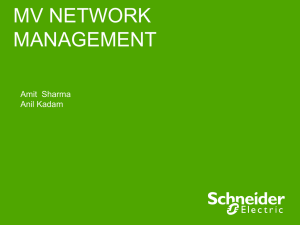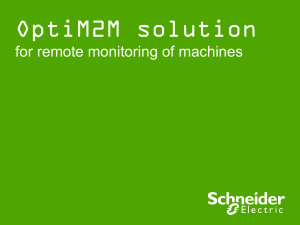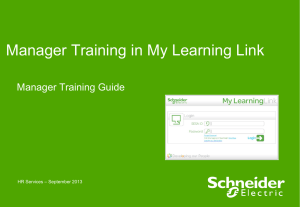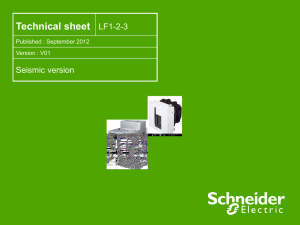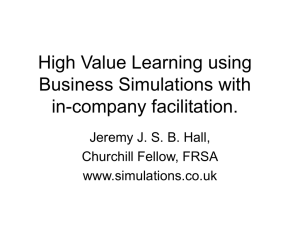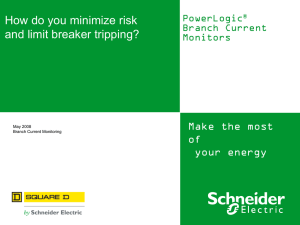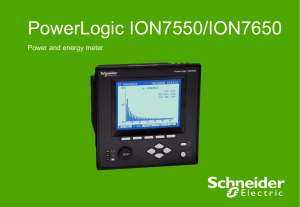OG TEMPLATE - India Smart Grid Forum
advertisement
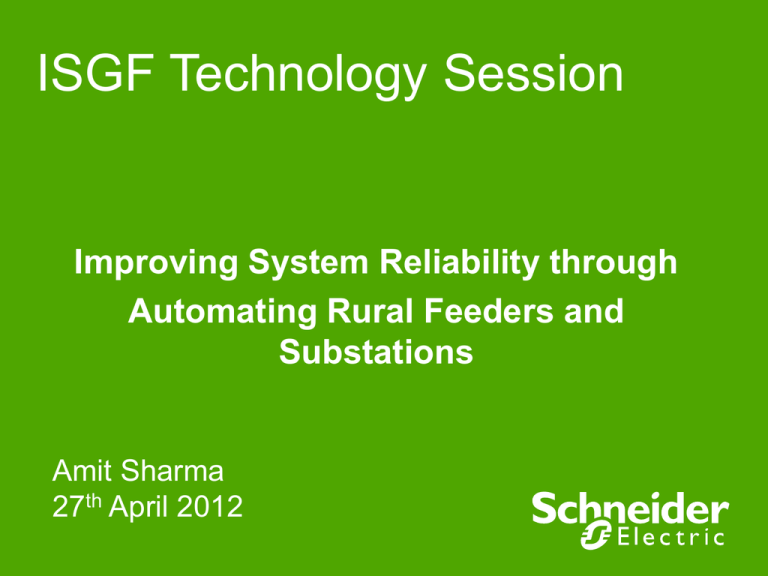
ISGF Technology Session Improving System Reliability through Automating Rural Feeders and Substations Amit Sharma 27th April 2012 Automatic Circuit Reclosers and Sectionalizers Amit Sharma 24th Nov 2011 Overhead Faults ● 60% - 70% of faults are of a transient (temporary) nature: • Conductors clashing in the wind • Tree branches falling on overhead conductors • Animals or birds getting curious • Lightning strikes An “auto-reclose” cycle should clear the fault • Some are more permanent: • Careless motor vehicle drivers • Operating error : leaving earths connected etc “lock out” of the section Schneider Electric - Energy – MONTHLY REVIEW 3 What is a Recloser ? ● A Recloser is a protection device: ● For overhead power lines ● It is a circuit breaker with more arduous test & install conditions ● Designed to RECLOSE on to a fault. ● Terminology ● The “auto-reclose” cycle ●Will detect a fault and open for a pre-programmed time, before closing again automatically ●This cycle can be repeated 3 times ●Lockout typically on the fourth trip Schneider Electric - Energy – MONTHLY REVIEW 4 What is a Sectionaliser ? ● A Sectionaliser is a switch: ● It is used in conjunction with an upstream “recloser” or “circuit breaker” ● It counts the interruption created by a recloser during a fault sequence. ● On a preset count ●trips during the dead time of the up stream recloser ●Isolates a faulty network section Schneider Electric - Energy – MONTHLY REVIEW 5 Benefit to the Customer ● Improved reliability of power supply ● Quality of supply ● Automatic recloser function - supply restoration after temporary faults ● Reduced outage time ● Minimise revenue loss ● Event Log and Remote control ● Reduce cost of fault finding ● Better knowledge of the network ● Reduction in the number of customer complaints Schneider Electric - Energy – MONTHLY REVIEW 6 MV NETWORK MANAGEMENT - why improve MV distribution? ● To obtain the best possible power quality The main issue is to reduce outage time and cost to the utility and its customers Schneider Electric - Energy – MONTHLY REVIEW 8 - how can outage time be reduced? ● By improving MV networks: ● By improving the MV networks management: Large number of short sections With Fault Passage Indicators (FPI’s) Redundant networks Or with remote controlled load break switches Reliable components… Or with fully automated reclosers and sectionalizers Schneider Electric - Energy – MONTHLY REVIEW 9 - different types of devices R Schneider Electric - Energy – MONTHLY REVIEW R2 10 - overhead networks: types of faults ● Temporary faults 80% Schneider Electric - Energy – MONTHLY REVIEW ● Permanent faults 20% 11 - temporary faults ● Temporary faults can be cleared by the use of Automatic Circuit Reclosers (ACRs) Schneider Electric - Energy – MONTHLY REVIEW 12 - temporary fault: one recloser R Schneider Electric - Energy – MONTHLY REVIEW 13 - temporary fault: one recloser O 15 s C R 100% Time Schneider Electric - Energy – MONTHLY REVIEW 14 - temporary fault: one recloser O 15 s 15 s C R 100% Time Schneider Electric - Energy – MONTHLY REVIEW 15 - temporary fault: one recloser O 15 s 15 s C R 100% Time Schneider Electric - Energy – MONTHLY REVIEW 16 - temporary fault: one recloser O 15 s 15 s 15 s C R 100% Time Schneider Electric - Energy – MONTHLY REVIEW 17 - temporary fault: one recloser O 15 s 15 s 15 s C R 100% Time 2 mn Schneider Electric - Energy – MONTHLY REVIEW 18 - temporary fault: TWO reclosers R1 Schneider Electric - Energy – MONTHLY REVIEW R2 19 - temporary fault: TWO reclosers R1 Network A50% R2 Network B50% Network B Time Schneider Electric - Energy – MONTHLY REVIEW 20 - permanent faults Permanent faults cannot be cleared by automatic reclosing To manage “permanent faults”, the best solution is to add some “sectionalizers” Schneider Electric - Energy – MONTHLY REVIEW 21 - case 1: no network automation Permanent fault R 100% 5H – 6H Schneider Electric - Energy – MONTHLY REVIEW 22 - case 1: no network automation Permanent fault R 100% 95% 5H – 6H Schneider Electric - Energy – MONTHLY REVIEW 23 - case 2: addition of non-communicating fault passage indicators (FPI) An FPI for each branch of the network R Add an FPI around each major «obstacle»… Schneider Electric - Energy – MONTHLY REVIEW 24 - case 3: addition of communicating FPIs R Put several communicating FPIs in strategic locations Schneider Electric - Energy – MONTHLY REVIEW 25 - case 4: addition of communicating FPIs and remote controlled load break switches T T R T T T remote controlled load break switches Communicating FPI Schneider Electric - Energy – MONTHLY REVIEW 26 - case 5: recloser and sectionalizer load break switches R Schneider Electric - Energy – MONTHLY REVIEW 27 - case 5: recloser and sectionalizer load break switches Sectionaliser load break switches are always associated with a recloser or circuit breaker: ● S1 = opens after ONE reclosing operation ● S2 = opens after TWO reclosing operations ● S3 = opens after THREE reclosing operations ● S4 = opens after FOUR reclosing operations Schneider Electric - Energy – MONTHLY REVIEW 28 - case 5: recloser and sectionalizer load break switches Permanent fault S3 R S4 S3 1 1 1 S2 S2 S1 Schneider Electric - Energy – MONTHLY REVIEW 29 - case 5: recloser and sectionalizer load break switches Permanent fault S3 R S4 S3 2 2 2 S2 S2 S1 Schneider Electric - Energy – MONTHLY REVIEW 30 - case 5: recloser and sectionalizer load break switches Permanent fault S3 R S4 S3 2 2 2 S2 S2 S1 2’ Schneider Electric - Energy – MONTHLY REVIEW 31 - case 5: recloser and sectionalizer load break switches Permanent fault S3 S4 R S3 S2 S2 S1 95 % 75 % 2’ 60’ Schneider Electric - Energy – MONTHLY REVIEW 32 - summary of overhead networks 1/2 Permanent fault 95% Case 1 A recloser 6h 95% Case 2 A recloser + FPIs 3h 95% Case 3 A recloser + FPI with Com 1h30 Schneider Electric - Energy – MONTHLY REVIEW 33 - summary of overhead networks 2/2 Permanent fault 95% Case 4: A recloser, 70 % remote controlled switches and FPI with Com 10 ’ 1 h 95% Case 5 75 % A recloser and sectionalizers 2’ Schneider Electric - Energy – MONTHLY REVIEW 1 h 34 SAIDI/SAIFI variations – Quality Power ● SAIDI (System Average Interruption Duration Index) can vary from a few minutes to several hours, ● SAIFI (System Average Interruption Frequency Index) can vary from 1 to 10 and more, depending on : ● population density (rural or urban area) ● proportion between underground and overhead distribution ● maximum accepted costs for non distributed energy Urban area Rural area Excellent Average < 10 mn 30 mn < 30 mn 2 hrs Poor >2 hrs >10 hrs Permanent Interruptions (>1 mn) Schneider Electric - Energy – MONTHLY REVIEW 35 33/11 KV Unmanned Remote Controlled S/s Schneider Electric - Energy – MONTHLY REVIEW 36 Compact, Unmanned, Remote controlled 33/11 KV S/s with 2 transformers each up to 10 MVA. ● Half space than a conventional s/s. ● Economic as very less civil work. ● Saving in execution time and costly land in urban areas app. ● Remote regular maintenance. ● CB,Current & Voltage sensors are life sealed ,insensitive to the environment. ● All types of protection OC,EF,UV,OV,OF,UF,DF, measurement KW,KWH,KVArH, data logging and event recording & self diagnostic facility helps to analyze the system and energy consumption. ● Delivers quality power. ● Automatic callout to the remote control station in case of predefined critical alarms. ● Communication with the remote central control station using GPRS Network or other media like GSM, 3G, PSTN, Leased Lines, Radio, VSAT etc. using established and field proven IEC 60870-5-104. Scalable to SCADA. ● Sub-station will have a unique aesthetic view in a crowded city. Schneider Electric - Energy – MONTHLY REVIEW 37 33/11 KV unmanned Remote controlled s/s within 25Mx15M space Schneider Electric - Energy – MONTHLY REVIEW 39 33/11 KV s/s at Judges Filed Guwahati with 2 Nos. 5 MVA Transformers. Schneider Electric - Energy – MONTHLY REVIEW 40 33/11 KV S/s at Kamakhya, Guwahati with 2x5MVA Trfr. Schneider Electric - Energy – MONTHLY REVIEW 41 Unmanned 33/11 KV , 10 MVA s/s at Nalagarh, HP Schneider Electric - Energy – MONTHLY REVIEW 42 Pole mounted 11 KV Breakers/AR ( Sub station Application) Schneider Electric - Energy – MONTHLY REVIEW 43 Channel Mounted 33 KV Breakers (SS Aplication) Schneider Electric - Energy – MONTHLY REVIEW 44 Typical layout of 33/11 KV s/s with 2 Nos. 5 MVA Trfr. Schneider Electric - Energy – MONTHLY REVIEW 45 Architecture – GPRS Control Center Remote Access to maintenance staff 14 ” LCD 14 ” LCD ADSL Line M2M Gateway ADSL Line GPRS Cloud Substation # 1 Future Substations (up to 30 nos.) 1 2 3 4 Br eake r C ontrol C ubic le Br eake r C ontrol C ubic le Br eake r C ontrol C ubic le Br eake r C ontrol C ubic le Br eake r C ontrol C ubic le RS 23 2 or Ethernet Port RS 23 2 Nule c D ir ect Protoc ol RS 23 2 Nule c D ir ect Protoc ol RS 23 2 Nule c D ir ect Protoc ol RS 23 2 Nule c D ir ect Protoc ol n Rs232 to Ethernet Converters (If required) Ethernet Switch SEPAM T-87 Ethernet Switch Leased Line Energy Meters CAT 5 CAT 5 Leased Line RS 485 (Modbus) Twisted Pair Cu GPRS Router GPRS Router Schneider Electric - Energy – MONTHLY REVIEW 46 Architecture – ASEB (Judge’s Field S/S) SMS or 3rd party SCADA WSOS Protocol Gateway Two way with Dynamic IPs Service provider independent VPN Data encryption Leased Line with Static IP Firewall Scalable to any third party SCADA Nulec Direct TCP/Modbus GPRS M2M Gateway VPN Tunnel GPRS (DHBVN’s Scope) VPN Tunnel using Remote Moblie VPN Judge’s Field S/S Judge’s Field S/S Schneider Electric - Energy – MONTHLY REVIEW 47 33KV Remote controlled VCB- substation application Schneider Electric - Energy – MONTHLY REVIEW 48 33KV substation and feeder breaker Schneider Electric - Energy – MONTHLY REVIEW 49 33 KV breaker in 33/11 KV S/S with 33/11 KV transformer Schneider Electric - Energy – MONTHLY REVIEW 50 33KV outdoor VCB Breaker in Pandav-Nagar ( Delhi) Schneider Electric - Energy – MONTHLY REVIEW 51 33KV Pole Mounted Breaker protecting a 10 MVA 33/11 KV Transformer Schneider Electric - Energy – MONTHLY REVIEW 52 Make the most of your energy™ Schneider Electric - Energy – MONTHLY REVIEW 62 Thank You!! Schneider Electric - Energy – MONTHLY REVIEW 63
